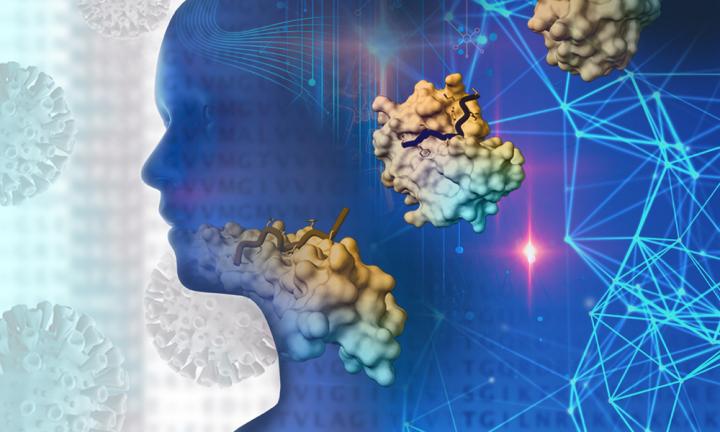
Credit: Rayne Zaayman-Gallant/EMBL
In the early days of the COVID-19 pandemic, it was established that SARS-CoV-2 infects cells by binding to the human protein ACE2, which plays a role in regulating blood pressure. But ACE2 is almost absent in human lung cells, so how can the lungs be one of the most affected organs in COVID-19? This gave researchers a hint that ACE2 might be more than just a blood pressure regulator, and might not be the only player in the SARS-CoV-2 infection mechanism.
EMBL’s Gibson team, in collaboration with Lucía Chemes at Universidad Nacional de San Martín in Buenos Aires and partners from Merck KGaA Darmstadt and University College Dublin, analysed sequences of ACE2 and other human proteins involved in SARS-CoV-2 infection, such as a class of proteins called integrins. They focused on short strings of amino acids called short linear motifs (SLiMs), which are involved in transmitting information between the inside and outside of cells. Quick identification and comparison of SLiMs was possible thanks to the Eukaryotic Linear Motif (ELM) resource, the largest curated SLiMs database, which the team and collaborators have been developing for 20 years.
They saw that ACE2 and several integrins contain SLiMs that are probably involved in endocytosis and autophagy – cellular processes of uptake and disposal of substances, respectively. This result suggests previously unknown roles of ACE2 and integrins in cell physiology. “If SARS-CoV-2 targets proteins involved in endocytosis and autophagy, it means these processes might be hijacked by the virus during infection,” says Bálint Mészáros, a postdoc in the Gibson team and the first author of the study.
Several findings were experimentally verified by Ylva Ivarsson and her group at Uppsala University in Sweden. They confirmed the predicted protein interactions, and verified that these interactions are regulated by the naturally occurring addition of ions containing phosphorus. “Ylva Ivarsson was the best person we knew of to test these predictions. We were delighted she agreed to join this project,” says EMBL team leader Toby Gibson. Ylva Ivarsson is equally enthusiastic. “Switching our work to SARS-CoV-2-related research helped us keep the spirit up in the lab during the pandemic,” she adds.
Potential drugs for COVID-19
The findings might lead to new therapeutic approaches for COVID-19. “SLiMs could ‘switch’ to turn viral entry signals on or off. This means that if we can find a way to reverse these switches using drugs, this might stop coronavirus from entering cells,” says senior author Lucía Chemes.
Together with a collaborator from Merck KGaA Darmstadt, the team gathered a list of existing drugs that interfere with endocytosis and autophagy. The list includes some surprising candidates, such as the antipsychotic chlorpromazine. “If clinical trials prove some of these drugs to work against COVID-19, this could be a game changer,” says Manjeet Kumar, a bioinformatics scientist in the Gibson team and a senior author in the study.
Highlights, challenges, and collaboration during the pandemic
This research was initiated at the beginning of the first lockdown in Germany in spring 2020. The project was an opportunity to strengthen relations between scientists across continents. “Toby and I have had a collaboration since 2012, when Argentina became an associate member of EMBL. Our previous experience enabled us now to work together on SARS-CoV-2,” says Lucía Chemes.
Working under lockdown conditions was not always easy. For example, one of the co-authors of the study, Elizabeth Martínez Perez from Leloir Institute in Argentina, was unable to return from her secondment in the Gibson team at EMBL Heidelberg.
At the same time, Manjeet Kumar had to adjust to working from home when his children were around. “I got kind support from our landlady to work in the attic of the building, though the internet signal wasn’t reaching there! Eventually I bought a 35 metre internet cable and connected it to the attic. Once this was set, I got momentum in the project,” he recalls.
For many, working on SARS-CoV-2 research was an inspiring experience. “We wanted to contribute to combating COVID-19. This gave us a common aim,” says Toby Gibson. Bálint Mészáros agrees. “It’s strange, thrilling, and a bit unsettling breaking new ground in the COVID-19 field,” he says. “As researchers we’re enthusiastic about figuring out bits of the biology, but at the same time we’re thoroughly excited to work on such an important topic.”
###
Media Contact
Mathias Jäger
[email protected]
Original Source
https:/
Related Journal Article
http://dx.




